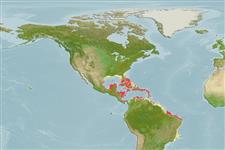>
Eupercaria/misc (Various families in series Eupercaria) >
Scaridae (Parrotfishes) > Scarinae
Etymology: Scarus: Greek, skaros = a fish described by anciente writers as a parrot fish; 1601 (Ref. 45335).
Eponymy: Paul Erdmann Isert (1756–1789) was a German botanist, also known for his opposition to the Danish-Norwegian slave trade. [...] (Ref. 128868), visit book page.
More on author: Bloch.
Environment: milieu / climate zone / пределы глубины / distribution range
экология
морской ассоциированный с рифами; пределы глубины 3 - 25 m (Ref. 9710). Subtropical; 23°C - 26°C (Ref. 130582); 33°N - 26°S, 98°W - 31°W
Western Atlantic: Bermuda, Florida (USA), Bahamas, and northeastern Gulf of Mexico to northern South America; throughout the Caribbean (Ref. 3802, 13628). Range probably extends to Brazil (Ref. 13628).
Length at first maturity / Size / Вес / Возраст
половая зрелость: Lm ?, range 16 - ? cm
Max length : 35.0 cm TL самец/пол неопределен; (Ref. 9710); common length : 18.0 cm TL самец/пол неопределен; (Ref. 3802)
колючие лучи спинного плавника (общее число) : 9; членистые (мягкие) лучи спинного плавника (общее число) : 10; колючие лучи анального плавника: 3; членистые (мягкие) лучи анального плавника: 9. White stripe above upper dark stripe ends at gill opening; upper and lower caudal margins pale (Ref. 26938). Terminal phase males are blue-green and orange, chest and head pink below a green band at lower edge of eye; median fins with blue borders, the broad central parts orange with linear blue markings (Ref. 13442).
Body shape (shape guide): fusiform / normal.
Found over shallow, clear waters, generally over Thalassia beds (Ref. 13628). Also found rocky or coral areas (Ref. 13628). A schooling species. Feeds on plants. A protogynous hermaphrodite (Ref. 55367). Super males spawn individually with striped females, while sexually mature males in the striped phase spawn in aggregation.
Life cycle and mating behavior
половая зрелость | размножение | нерест | икра | Fecundity | личинки
Diandric. Length at sex change = 9.6 cm TL (Ref. 55367). Forms harem groups composed of a single male and several smaller females (Ref. 55367).
Böhlke, J.E. and C.C.G. Chaplin, 1993. Fishes of the Bahamas and adjacent tropical waters. 2nd edition. University of Texas Press, Austin. (Ref. 5521)
Статус Красного Списка МСОП (Ref. 130435: Version 2025-1)
Угроза для людей
Reports of ciguatera poisoning (Ref. 30911)
Использование человеком
рыболовство: не имеет хозяйственного значения; аквариум: коммерческий
дополнительная информация
инструменты
Специальные отчеты
Скачать в формате XML
ресурсы в Интернет
Estimates based on models
Preferred temperature (ссылка
123201): 26.3 - 28.2, mean 27.4 °C (based on 645 cells).
Phylogenetic diversity index (ссылка
82804): PD
50 = 0.5000 [Uniqueness, from 0.5 = low to 2.0 = high].
Bayesian length-weight: a=0.01096 (0.00705 - 0.01705), b=3.01 (2.88 - 3.14), in cm total length, based on LWR estimates for this species & Genus-body shape (Ref.
93245).
Trophic level (ссылка
69278): 2.0 ±0.0 se; based on diet studies.
устойчивость к внешним воздействиям (ссылка
120179): высокий, минимальное время удвоения популяции до 15 месяцев (Preliminary K or Fecundity).
Fishing Vulnerability (Ref.
59153): Low vulnerability (25 of 100).
🛈
Nutrients (Ref.
124155): Calcium = 36.8 [20.5, 68.6] mg/100g; Iron = 0.994 [0.617, 1.743] mg/100g; Protein = 19.4 [17.3, 21.2] %; Omega3 = 0.135 [0.077, 0.254] g/100g; Selenium = 10.9 [5.3, 21.4] μg/100g; VitaminA = 18.9 [4.6, 78.1] μg/100g; Zinc = 1.74 [1.18, 2.59] mg/100g (wet weight);
